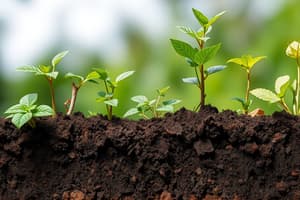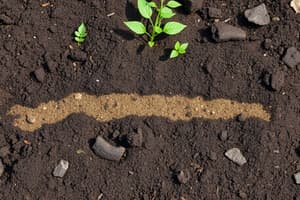Podcast
Questions and Answers
What is one primary role of soil in agricultural practices?
What is one primary role of soil in agricultural practices?
- It prevents soil erosion effectively.
- It stores and releases water for plant hydration. (correct)
- It provides aesthetic value to the landscape.
- It regulates the climate by reflecting sunlight.
Which type of soil is characterized by expansive clays that swell and contract with moisture changes?
Which type of soil is characterized by expansive clays that swell and contract with moisture changes?
- Alluvial soils
- Vertisols (correct)
- Sandy soils
- Lateritic soils
How does soil contribute to biodiversity?
How does soil contribute to biodiversity?
- By providing minerals that plants cannot utilize.
- By controlling atmospheric temperatures.
- By supporting a wide range of organisms' habitats. (correct)
- By acting as a barrier against pests.
Which type of soil is primarily characterized by iron and aluminum oxides?
Which type of soil is primarily characterized by iron and aluminum oxides?
What is a potential consequence of soil degradation?
What is a potential consequence of soil degradation?
What primarily influences the mineral composition and texture of soil?
What primarily influences the mineral composition and texture of soil?
How does climate influence the rate of soil formation?
How does climate influence the rate of soil formation?
What characterizes the layers or horizons found in soil profiles?
What characterizes the layers or horizons found in soil profiles?
Which of the following best describes soil porosity?
Which of the following best describes soil porosity?
What does soil cation exchange capacity (CEC) indicate?
What does soil cation exchange capacity (CEC) indicate?
Which of the following accurately describes soil texture?
Which of the following accurately describes soil texture?
What impact does topography have on soil formation?
What impact does topography have on soil formation?
Which soil property is crucial for optimal plant growth due to its effect on nutrient availability?
Which soil property is crucial for optimal plant growth due to its effect on nutrient availability?
Flashcards
Soil Classification
Soil Classification
Soil types are categorized into groups based on their characteristics, such as texture, composition, and location.
Sandy Soil
Sandy Soil
Sandy soils have large particles, drain quickly, and are well-suited for crops needing good drainage.
Clayey Soil
Clayey Soil
Clayey soils have small particles, hold water tightly, and can become compacted.
Soil as a Plant Growth Medium
Soil as a Plant Growth Medium
Signup and view all the flashcards
Soil's Role in Water Cycles
Soil's Role in Water Cycles
Signup and view all the flashcards
What are the main factors that influence soil formation?
What are the main factors that influence soil formation?
Signup and view all the flashcards
What is parent material in terms of soil?
What is parent material in terms of soil?
Signup and view all the flashcards
How does climate affect soil formation?
How does climate affect soil formation?
Signup and view all the flashcards
How does biological activity influence soil formation?
How does biological activity influence soil formation?
Signup and view all the flashcards
What is soil structure?
What is soil structure?
Signup and view all the flashcards
What is soil texture?
What is soil texture?
Signup and view all the flashcards
What is soil cation exchange capacity (CEC)?
What is soil cation exchange capacity (CEC)?
Signup and view all the flashcards
What is soil permeability?
What is soil permeability?
Signup and view all the flashcards
Study Notes
Soil Formation
- Soil formation is a complex process involving weathering of parent material, biological activity, and the influence of climate and topography.
- The rate of soil formation varies significantly depending on these factors.
- Parent material, the initial unconsolidated geological material from which soil develops, influences the mineral composition and texture of the resulting soil.
- Climate plays a crucial role in the rate and type of weathering processes that occur. Higher temperatures and rainfall generally lead to faster weathering and soil formation.
- Biological activity, including plant roots, soil organisms (bacteria, fungi, worms), and animals, profoundly affects soil structure, nutrient cycling, and overall soil health. Root systems physically break up the parent material, and decomposers contribute to nutrient release.
- Topography, or the slope of the land, affects drainage patterns and water accumulation. Steeper slopes can lead to greater erosion, limiting soil development.
- Different types of soil formation processes lead to distinct soil profiles, including horizons, characterized by differences in color, texture, structure, and organic matter content.
Soil Properties
- Soil texture refers to the relative proportions of sand, silt, and clay particles. Different combinations dictate various drainage, aeration, and water-holding capacities.
- Soil structure describes the arrangement of soil particles into aggregates, impacting pore space and water infiltration.
- Soil porosity involves the volume of pore spaces in the soil. Pore space is critical for water movement and aeration.
- Soil pH represents the acidity or alkalinity of soil. Optimal pH conditions support healthy plant growth by affecting nutrient availability.
- Soil organic matter content is vital for soil health. It improves soil structure, increases water retention, and provides essential nutrients.
- Soil color varies based on factors like degree of organic matter, presence of iron oxides, and presence of clay minerals.
- Soil permeability describes the rate at which water can move through soil. Permeability varies with texture and pore space.
- Soil cation exchange capacity (CEC) quantifies the soil's ability to hold onto and release essential nutrients. Higher CEC soils are generally more fertile.
Soil Types
- Different soil types are categorized based on various characteristics and criteria.
- Soil classification systems help organize and manage soil resources. Examples include soil orders, suborders, great groups, subgroups, families, and series.
- Understanding different soil types is essential for agricultural practices, environmental management, and land use planning. The characteristics of different soils dictate how well suited they are to particular crops and land uses.
- Examples include sandy soils, clayey soils, silty soils. Each has unique features.
- Other soil types like alluvial soils, peat soils, and desert soils are characterized by location and conditions that lead to different compositions and properties.
- Lateritic soils are characterized by iron and aluminum oxides. Vertisols feature expansive clays that swell and contract with moisture changes.
Soil Functions
- Soil provides a medium for plant growth by supporting root systems, holding water and nutrients, and allowing for gas exchange.
- Soil acts as a crucial component in regulating water cycles by storing and releasing water.
- Soil plays a critical role in nutrient cycling, processing organic matter and making nutrients available to plants.
- Soils are vital for supporting biodiversity by providing habitat for a wide range of organisms.
- Soils store and filter water, helping to purify rainwater and groundwater.
- Soils influence the release of greenhouse gases from the soil.
- Soil degradation due to erosion and poor management practices can have significant environmental impacts.
Studying That Suits You
Use AI to generate personalized quizzes and flashcards to suit your learning preferences.




